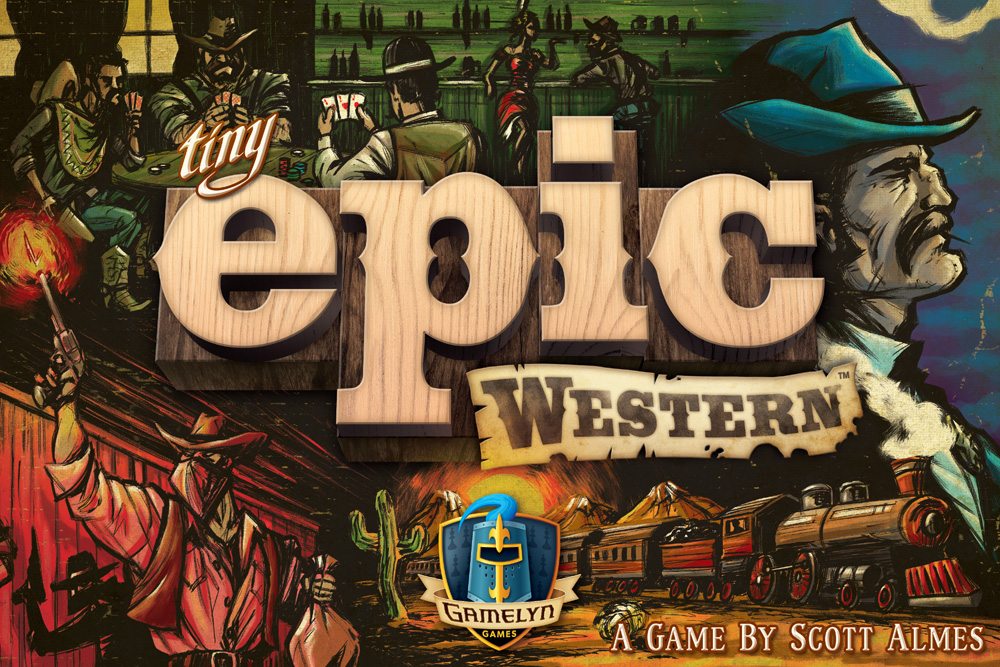Put on your hats and have your six-shooters ready! It’s time for a couple rounds of tiny epic poker, which might lead to some tiny epic duels in this tiny epic town. You guessed it: we’re playing Tiny Epic Western.
At a glance: Tiny Epic Western is a game by Scott Almes for 2 to 4 players, ages 14 and up, and takes about 45 minutes to play. It’s currently seeking funding on Kickstarter (just launched this morning), with a pledge of $18 for a copy of the base game, or $24 for the deluxe edition (which includes some extra characters and dice). The game is okay for younger players, as long as they have some experience with both poker and worker placement games, but there isn’t any inappropriate content.
New to Kickstarter? Check out our crowdfunding primer.

Components
- 1 Town Hall board
- 1 Sheriff’s Office board
- 4 Location boards (1 per player)
- 1 Wanted Card
- 4 Boss cards (1 per player)
- 30 Building cards
- 20 Poker cards (value 1-5 in four suits)
- 12 Posse Member meeples (3 per player color)
- 2 Gunslinger dice
- 1 First Player token
- 12 Resource cubes (1 each Money, Law, and Force per player)
- 3 Industry tokens (Mining, Railway, Wagon)
I was sent a prototype to play, so the component quality is not final in the photos shown here. However, much of the artwork is already complete. From previous games in the Tiny Epic series, I know that you can expect pretty nice components from Gamelyn Games, particularly if stretch goals are met (and I’m guessing they will be). I do know that the game will include 4 Boss cards from the beginning, but there are several more planned (my review prototype actually included 6 of them).

In the prototype the Gunslinger dice are just standard dice, but as you can see on the Kickstarter page, the finished game will have custom bullet-shaped dice. The Poker cards have a weathered look to them, with four custom suits: Cattle, Horseshoes, Teepees, and Hats.
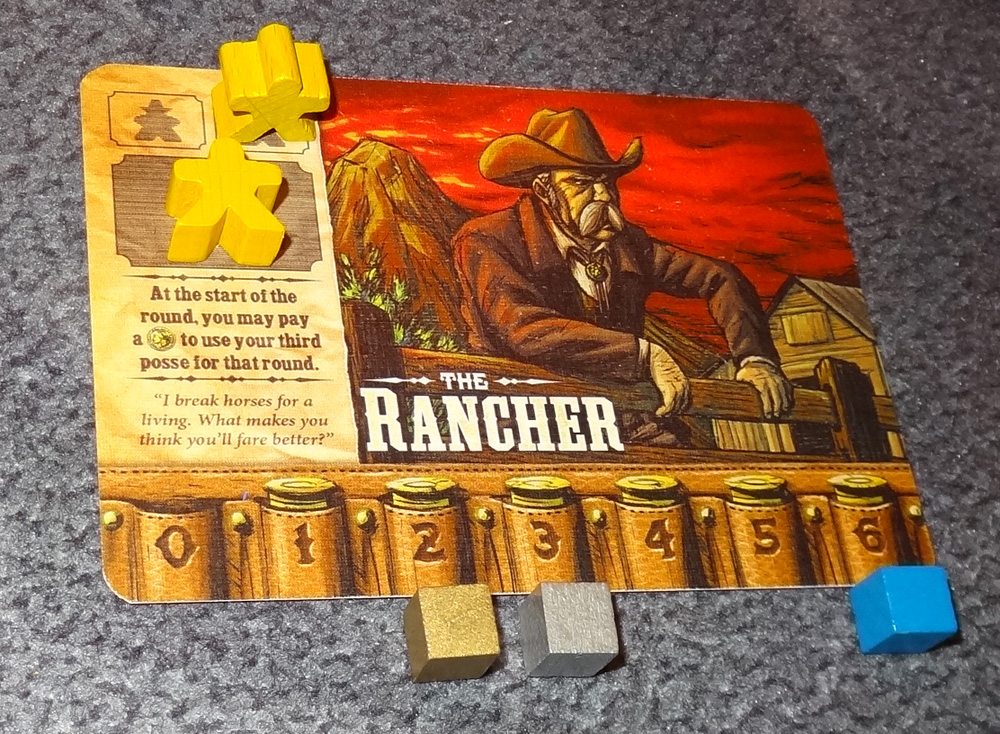
Each player’s Boss card has spaces for three Posse Members, a description of the Boss’s ability, and then an area across the bottom for tracking resources. Most of the Boss card is a portrait of the Boss. It might be nice to have a slightly smaller portrait so that you could put all three resource cubes on the card itself; right now, if you have the same number of all three resources, you’ll either have to stack them on top of each other or run them off the edge of the card.

The Location Boards (plus the Town Hall and Sheriff’s Office) have various spaces marked with a meeple for placing your Posse Members. the boards are cut so that they can be arranged in a ring, with cards in between the locations. Each location also has an illustration of the building, and a reward for winning the poker hand at that location (marked with a pile of chips).

The Building cards have a lot of different information on them. First, there are some icons that match the industry tokens across the top, along with a victory point number. In the center of the card is the building’s ability and an illustration of the building. At the bottom on the “porch” area, are some symbols indicating the building’s purchase cost.
How to Play
The goal of the game is to score the most points by buying buildings and manipulating the industry tokens for bonuses.
To set up, each player takes a Location board, Posse Members of that color, a Boss card, and three resource tokens. Each player puts two Posse Members standing up on their Boss card, with the third lying down on the space provided. Pick a player to get the First Player token.
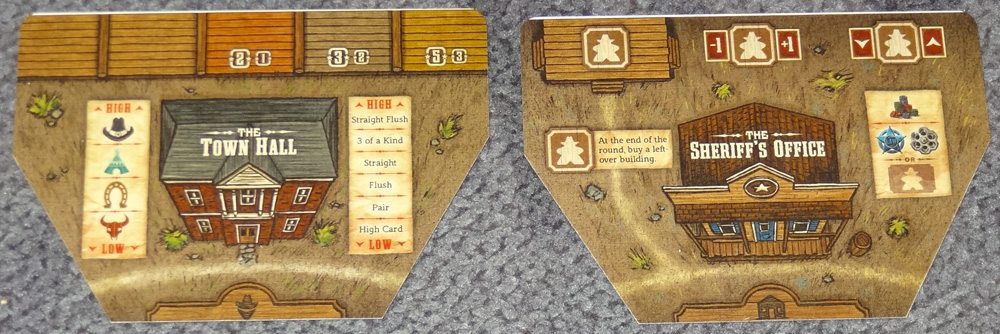
The Location boards are placed in a ring, with the Town Hall opposite of the Sheriff’s Office, and player Location boards near the players. Any unused player Location boards are flipped over to the neutral (uncolored) side. The industry tokens are placed near the Town Hall board. The Building cards are shuffled and set aside, and the Poker cards are also shuffled and set aside. The Wanted card is placed at the center of the ring with the dice on it.
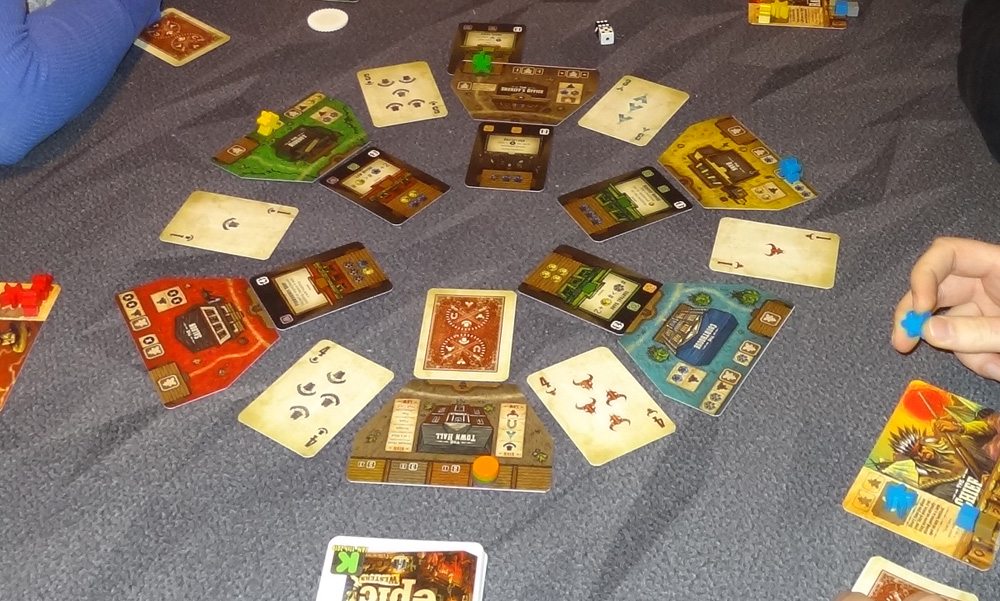
To start a round, first deal out buildings: each unused location and the Sheriff’s Office gets a building attached to the “porch” spot (on the outside of the ring). These buildings will be available to use. Then, deal out buildings on the inside of the ring until each Location except the Town Hall has one–these buildings will be available to purchase.
Then, deal poker cards: deal one face-up card between every pair of locations. Then deal one face-down poker card below the Town Hall card–this is the Rival card. Finally, give each player 2 poker cards. Each player chooses a card to keep and discards the other face-down.
Next comes Posse placement: In turn order, each player places one Posse Member on a placement point and takes the associated action. Continue until everyone has placed all available Posse Members.

The player Location boards have two placement points each: the porch and an influence point. The porch lets you use the action of the building there, if any. The influence point will let you take some type of influence (resource), but you have to decide: 1 influence immediately, or 2 influence if you win the poker hand there later.
The Sheriff’s Office has a porch, too, but has a couple of different placement points. There are two spots that alter your poker card: one can increase or decrease the value by one, and the other increases or decreases the suit value by one. The final location gives you the opportunity to buy a second building at the end of the buy phase.
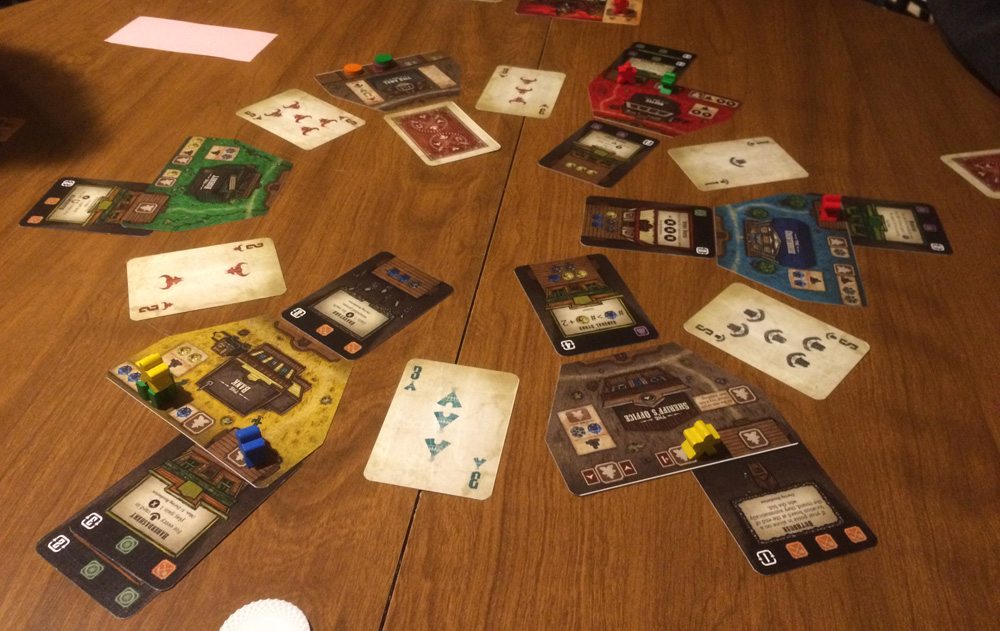
If you want a location that’s already occupied, you can start a duel. Place your Posse Member next to the spot you want to take. You and the defender each roll a Gunslinger die. Higher number wins, with ties going to the defender. The loser gets one chance to respond first, and then the other player gets one chance to respond. To respond, you may reveal your poker card to add its value to your die, or you may pay influence to re-roll your die (attackers pay Force, defenders pay Law)–1 influence per re-roll. You may do both of these actions. Once you’re satisfied with your response, then the other player may respond if they are now losing. The loser’s Posse Member is laid down on its side (wounded) with the winner’s Posse Member standing on it, and wounded members do not get the benefit of the placement point (unless it was an instant ability already taken). Note: if you’ve already revealed your poker card in a duel this round, you can’t use it again.
Whoever wins a duel gets the Wanted card. If you have the Wanted card at the end of the round, you get 1 influence of your choice. If you have it at the end of the game, you get 2 bonus victory points.
Next, we have the Resolution phase: going clockwise from the Town Hall board, resolve each location board. Everyone reveals their Poker cards. Look at the two Poker cards next to each Location and see who has the best 3-card Poker hand, among the people who have Posse Members at that Location (including wounded). If you are the only player at a Location, you must compete against the Rival card (below Town Hall). The winner gets to take the influence shown on the card. At the Sheriff’s Office, the winner may choose between taking influence or standing up the third Posse Member to use for the next round.
Poker ties are broken by high suit; if there’s still a tie, both players collect the winnings.
Finally, you compare poker hands with the Town Hall cards. This will determine the order of buying buildings, and also who gets to move the industry token. For ties at Town Hall that aren’t broken by suit, they’re broken by removing card modifiers and comparing natural hands.
In poker hand order, players may each buy one building. You may only buy a building if you have a Posse Member at that location (even if it’s wounded). Pay the resources shown on the card, and then place that building on the porch on your Location board, splaying out any previous buildings so the industry icons are visible. If you do not buy a building, you may stand up your third Posse Member for use during the next round. Finally, if any player took the “buy second building” point on the Sheriff’s Office, they get a chance to purchase a second building from anything that’s left.
The winner of the Town Hall poker hand also gets to advance one of the industry tokens. If it’s off the board, it moves onto the 3rd place spot first, and then advances from there. By the end of the game (six rounds), only one token will be on each spot.
Then, the first player token is passed, everyone gets their Posse Members back, and begin the next round. (Note that activating your third Posse Member is always only for one round–you’ll need to activate it again if you want to use it again.)
Once the game ends, add up all the victory points on the buildings you own. Then, look at the industry tokens. The player with the most icons of each color gets the bigger number of points matching the industry token, and the player with second-most gets the smaller number. Ties go to the player with the most building cards.

The Verdict
As you probably know, I’m a fan of the Tiny Epic series of games designed by Scott Almes and published by Gamelyn Games, and I’m definitely not alone. The Kickstarter campaigns for the previous games (Tiny Epic Kingdoms, Tiny Epic Defenders, Tiny Epic Galaxies, and Tiny Epic Kingdoms: Heroes’ Call) have all funded and hit a lot of stretch goals along the way. I’ve enjoyed several other games by Scott Almes as well, but I especially love this series for the way it fits big gameplay in a small package.
Tiny Epic Western is a fun mixture of poker and worker placement, and it introduces some new tweaks to the worker placement genre that I hadn’t seen before. One of my friends felt like the 3-card poker was a little odd and preferred a full 5-card hand, but I think it’s appropriate that a Tiny Epic game uses 3-card hands. That does mean that you do get wins determined by high card, but there do seem to be a lot of straights–particularly because you can manipulate your cards.
The biggest difference from a traditional worker placement game is that when you take a spot, there’s still a chance that somebody else could go there and take it from you. In most worker placement games, part of the strategy is taking a spot that you know somebody else wants to use. In Tiny Epic Western, taking a spot isn’t guaranteed to lock other people out–but if they want to use it, they’ll have to start a duel.
The duel is a fun mechanic, and one that fits well with the theme. It starts off with just a die roll, high number wins–but then you can spend resources to increase your result. It means that you have to decide before you start a duel how badly you want a location and how much you’re willing to spend on re-rolls. Or, if you have a high card in your pocket, you may have a pretty good chance of winning–but do you want to show your cards so soon? It makes for some interesting decisions throughout the game.
The placement points also have multiple functions, though. Aside from the placement point’s direct ability, placing your worker also gets you to the poker table, so to speak, and also gives you an opportunity to buy the building at that location. So even if you lose a duel, getting your Posse Member to a location may be worth it if you think you’ve got a good chance of winning the poker hand or you really need that building.
I also like that the influence-collection spots give you two choices: you can either take one now, or bet that you’ll win the poker hand for double the reward. However, if you choose the double reward and somebody wins a duel against you, you get nothing. If you already took the one influence and somebody duels you, you’ve really got nothing to lose.
Generally in a worker-placement game, the more workers you have, the better off you are. Sure, maybe there are increased upkeep costs or something, but the extra actions are usually worth it. Getting an extra worker earlier than other players can be a huge advantage. In Tiny Epic Western, earning your third worker is only for one round at a time, and the usual way it happens is if you didn’t buy a building. So it’s a trade-off, losing the chance to earn points for an entire round to get that third worker. There are other ways to get it, too, like forgoing your influence winnings at the Sheriff’s Office, but it does seem to even out that first-mover advantage you see in most worker-placement games.
The buildings have a nice mix of abilities–some have instant abilities, some work during the Resolution phase, and some happen when you buy buildings. The fact that only the most recently purchased building for each player are active makes for an interesting board, too–many buildings are only used once or twice before they get replaced, so if you see an ability you want to use, you have to seize the opportunity.
I do like the mix of player abilities on the Boss cards, though I know there have been some tweaks since the version I have. We had some concerns that some abilities were significantly stronger than others, but I’ve gotten a sneak peek at the current revisions and they look more balanced. I’ll be interested to see how they turn out in the end.
The game did go just slightly longer than some of my gamers have preferred. It’s a 6-round game, I think largely for getting the industry tokens into the 1st, 2nd, and 3rd place spots, but other than that function I’m not convinced that the game needs to be that long. You do get a pretty good feel for what’s going on in about 4 or 5 rounds, but whether that’s long enough to plan out strategies is sort of up in the air. That’s probably my only real complaint, though, and one that may also solve itself because games will go more quickly when players are familiar with it.
Because the game involves poker and a randomized draw for new buildings, it does have slightly more luck than some of the other Tiny Epic games like Kingdoms and Galaxies. However, there are ways to play the odds–as in poker–and although luck is a factor, so is knowing when to hold ’em and when to fold ’em.
Overall, I think Almes and Gamelyn Games have another winner on their hands. Saddle up your horses and check out the Kickstarter page now so you don’t get left in the dust!
Disclosure: I received a prototype of this game for review.

